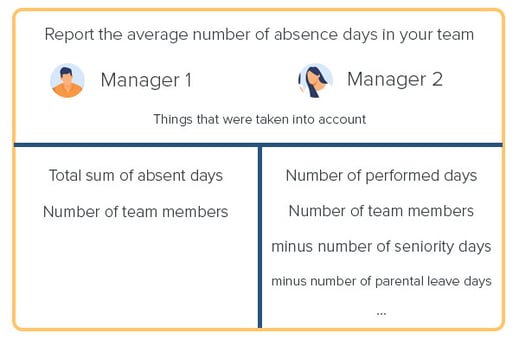Organizational silos are increasingly seen as problematic in companies in full expansion. They refer to the gap between different departments, data, managers and the corporate vision. And, just when you need data the most, they make data-driven decision-making seem implausible. But how do you conquer it, and above all, how do you do it in times of a work-at-home economy?
Article en français - Artikel in het Nederlands
What are organizational silos?
When it comes to strategic decisions, your gut feeling can lead the way. But it can also saddle you with a lot of gut pain when things go wrong. Data-driven decision-making is in such cases often the cure. However, a data-driven culture is not something you establish overnight.
Many companies think they are pursuing a data-driven model, because they are making decisions based on KPIs that have been defined with great precision. Only, they often overlook an important organizational step in this process.
How is data and information shared, who maintains the overview, and in what ways can we work together around data?
Transparency and collaboration are the primary objectives here, and it's the lack thereof, that creates organizational silos (others refer to it as data-silos). While no company creates them on purpose, it's helpful to recognize the emergence of organizational silos. And to know what you can do about them so that data-driven decisions don't leave you with a bitter pill to swallow.
Where do organizational silos come from?
Although others often refer to data silos, we prefer to call it organizational silos. Because it is about a problem that is rooted deeper than just data.
Companies of all sizes have to deal with it, and it is also one of the most cited pain points by c-levels in the Deloitte's Industry 4.0 readiness report.

“Small challenges can be solved by one actor alone, but the challenges that we all face today are too big to handle in isolation. Mutual learning and collaboration is the way forward".
Flemming Besenbacher - Carlsberg chairman
A lack of team spirit
A glance into the conference room during a board meeting is often enough to recognize de symptoms of silo formation. Organizational silos often arise from our egos or when a particular manager and possibly employees begin to show more loyalty to a particular team or ideology than to the organization as a whole.
It causes us to become more detached, we share less information, and therefore we interact less with certain teams. Often it doesn't even have to be that black or white. Team spirit is closely related to how an organization treats its people: are there competitions set up within the company that pit teams against each other for an incentive or do departments work together to achieve their goals?
A lack of team spirit indirectly means a lack of communication between the department. Transparent communication ensures that we do not set our own goals but that we share goals with others. A healthy team spirit, will help you achieve your goals because they are in line with the company vision that was previously determined unanimously and collectively by the board.
HR, Marketing, operations, sales and any other department, we all have our own processes, challenges or tasks. We work in physically separated rooms or have our own Teams chat since COVID-19. All this makes it natural to think of ourselves as a segregated part and only complicates the company-wide team spirit and the way data or information is shared. My colleague Jorn wrote an interesting article on how to boost company culture online.
It's a growing pain
All in all considered, enterprise-wide information sharing is a fairly new aspect. Especially when you are going through all the steps towards a data-driven culture (and you are aware of organizational silos). 😅
Before we put our data in the cloud, it was natural for each department to set up its own Excel or to use a different Business Intelligence software. But now that we are increasingly using cloud technologies to have our conversations (think of Teams, Rooftop, Slack, ...) we need to think thoroughly about clear procedures and policies. Because, how are we going to handle this as our company grows?
In growing companies, unintentional gaps often occur. On the one hand with the arrival of new people and on the other hand by the lack of procedures.
In the first case, new people need to be properly inducted. More often than not, they already have a background from a previous employer through which they have already developed a way of working (after all, we are creatures of habit). If this is not the case, they still need to be introduced to the rules of the game:
Who is who, how do all the departments work, who manages this, how do I make reports?
All these questions should be part of the onboarding of new colleagues in the company. Unfortunately, that is often not the case. Especially if a company is growing rapidly. This also happens to managers who communicate about their data, but not about how they get to the data).

Above, you'll find a great example of two figures that were reported without first agreeing on a unified process for it. Both managers collected their data individually, figured out their own way of calculating it, and stored it separately. Just like that, an organizational silo was created that would give data-driven decisions very little added value.
Summary - How to break the silos?
Long story short, organizational silos are not healthy for your business. Not only do they cause data to be misinterpreted, they slow down your organization and are harmful for your customer satisfaction. Your management may have a good strategy or vision, but it's worth nothing if everyone is not singing from the same hymn sheet. Organizational silos often arise from poor communication that started during a management meeting and has been carried over to the workplace.
COVID-19 has made it even more difficult to break-down silos. Especially because of new Work From Home policy, we ended up communicating less with other teams (say goodbye to the good old coffee machine moments). Also, because online team-spirit was hard to maintain. Fortunately, organizational silos are relatively easy to break-down:
- Share your company vision and help everyone understand it. Provide opportunities for your employees/colleagues to see how they contribute to this shared goal.
- Support cross business-line initiatives. Form teams that work closely together and communicate openly to strengthen the team spirit.
- Consider out of work events. Provide opportunities for your teams or individuals to get to know each other. Even a training course can be enough to create a team-bond.
- Provide the right technologies. The right software can do wonders. Offer a tool that easily integrates with others, that can share data while also including the collaborative aspect.
- Take time to create or update procedures around on-boarding, sharing information or data, collaborating and the way ideas are pitched.
- Dare to question data. Investigate the source and look beyond the outcome. Who knows, you may find new KPIs or track things that haven't mattered for years.
- Above all, ensure transparency (not too much, but enough). This allows departments and teams to have insight into how they can contribute to the success of others and, in the process, the organization as a whole.





